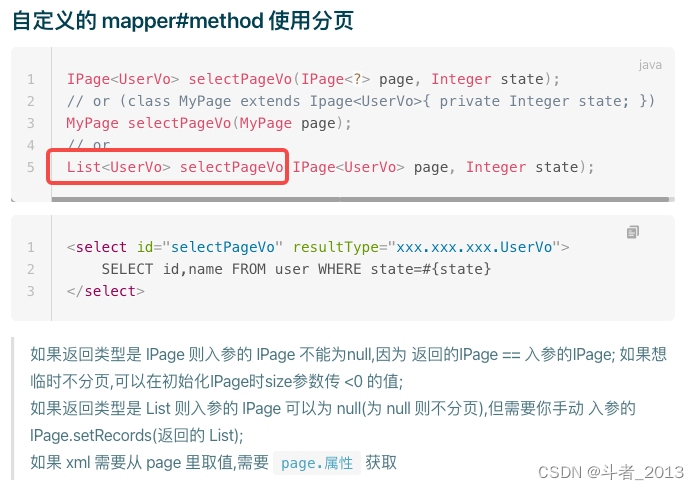前言
例如:随着人工智能的不断发展,机器学习这门技术也越来越重要,很多人都开启了学习机器学习,本文就介绍了机器学习的基础内容。
一、官方文档
Mybatis-Plus分页插件:https://baomidou.com/pages/97710a/
PageHelper分页插件:https://pagehelper.github.io/
Tip⚠️:
官网链接,第一手资料。
二、内置的分页方法
1、内置方法
在Mybatis-Plus的BaseMapper中,已经内置了2个支持分页的方法:
public interface BaseMapper<T> extends Mapper<T> { <P extends IPage<T>> P selectPage(P page, @Param("ew") Wrapper<T> queryWrapper); <P extends IPage<Map<String, Object>>> P selectMapsPage(P page, @Param("ew") Wrapper<T> queryWrapper); …… }
2、selectPage单元测试
使用selectPage方法分页查询年纪age = 13的用户。
@Test public void testPage() { System.out.println("----- selectPage method test ------"); //分页参数 Page<User> page = Page.of(1,10); //queryWrapper组装查询where条件 LambdaQueryWrapper<User> queryWrapper = new LambdaQueryWrapper<>(); queryWrapper.eq(User::getAge,13); userMapper.selectPage(page,queryWrapper); page.getRecords().forEach(System.out::println); }
执行结果:
查询出了表中满足条件的所有记录,说明默认情况下,selectPage方法并不能实现分页查询。
3、PaginationInnerInterceptor分页插件配置
mybatis-plus中的分页查询功能,需要PaginationInnerInterceptor分页插件的支持,否则分页查询功能不能生效。
@Configuration public class MybatisPlusConfig { /** * 新增分页拦截器,并设置数据库类型为mysql */ @Bean public MybatisPlusInterceptor mybatisPlusInterceptor() { MybatisPlusInterceptor interceptor = new MybatisPlusInterceptor(); interceptor.addInnerInterceptor(new PaginationInnerInterceptor(DbType.MYSQL)); return interceptor; } }
再次执行单元测试:
先执行count查询查询满足条件的记录总数,然后执行limit分页查询,查询分页记录,说明分页查询生效。
三、分页原理分析
查看PaginationInnerInterceptor拦截器中的核心实现:
//select查询请求的前置方法 public void beforeQuery(Executor executor, MappedStatement ms, Object parameter, RowBounds rowBounds, ResultHandler resultHandler, BoundSql boundSql) throws SQLException { //根据请求参数来判断是否采用分页查询,参数中含有IPage类型的参数,则执行分页 IPage<?> page = (IPage)ParameterUtils.findPage(parameter).orElse((Object)null); if (null != page) { boolean addOrdered = false; String buildSql = boundSql.getSql(); List<OrderItem> orders = page.orders(); if (CollectionUtils.isNotEmpty(orders)) { addOrdered = true; buildSql = this.concatOrderBy(buildSql, orders); } //根据page参数,组装分页查询sql Long _limit = page.maxLimit() != null ? page.maxLimit() : this.maxLimit; if (page.getSize() < 0L && null == _limit) { if (addOrdered) { PluginUtils.mpBoundSql(boundSql).sql(buildSql); } } else { this.handlerLimit(page, _limit); IDialect dialect = this.findIDialect(executor); Configuration configuration = ms.getConfiguration(); DialectModel model = dialect.buildPaginationSql(buildSql, page.offset(), page.getSize()); MPBoundSql mpBoundSql = PluginUtils.mpBoundSql(boundSql); List<ParameterMapping> mappings = mpBoundSql.parameterMappings(); Map<String, Object> additionalParameter = mpBoundSql.additionalParameters(); model.consumers(mappings, configuration, additionalParameter); mpBoundSql.sql(model.getDialectSql()); mpBoundSql.parameterMappings(mappings); } } }
再来看看ParameterUtils.findPage()方法的实现:
//发现参数中的IPage对象 public static Optional<IPage> findPage(Object parameterObject) { if (parameterObject != null) { //如果是多个参数,会转为map对象;只要任意一个value中包含IPage类型的对象,返回IPage对象 if (parameterObject instanceof Map) { Map<?, ?> parameterMap = (Map)parameterObject; Iterator var2 = parameterMap.entrySet().iterator(); while(var2.hasNext()) { Entry entry = (Entry)var2.next(); if (entry.getValue() != null && entry.getValue() instanceof IPage) { return Optional.of((IPage)entry.getValue()); } } //如果只有单个参数,且类型为IPage,则返回IPage对象 } else if (parameterObject instanceof IPage) { return Optional.of((IPage)parameterObject); } } return Optional.empty(); }
小结:
mybatis-plus分页查询的实现原理:
1、由分页拦截器PaginationInnerInterceptor拦截所有查询请求,在执行查询前判断参数中是否包含IPage类型的参数。
2、如果包含IPage类型的参数,则根据分页信息,重新组装成分页查询的SQL。
四、自定义分页方法
搞清楚mybatis-plus中分页查询的原理,我们来自定义分页查询方法。
这里我使用的是mybatis-plus 3.5.2的版本。
<dependency> <groupId>com.baomidou</groupId> <artifactId>mybatis-plus-boot-starter</artifactId> <version>3.5.2</version> </dependency>
在UserMapper中新增selectPageByDto方法。
public interface UserMapper extends CommonMapper<User> { /** * 不分页dto条件查询 * @param userDto * @return */ List<User> selectByDto(@Param("userDto") UserDto userDto); /** * 支持分页的dto条件查询 * @param page * @param userDto * @return */ IPage<User> selectPageByDto(IPage<User> page,@Param("userDto") UserDto userDto); }
说明:
1、mybatis-plus中分页接口需要包含一个IPage类型的参数。
2、多个实体参数,需要添加@Param参数注解,方便在xml中配置sql时获取参数值。
UserMapper.xml中的分页sql配置:
这里由于selectByDto和selectPageByDto两个方法都是根据dto进行查询,
sql语句完全一样,所以将相同的sql抽取了出来,然后用include标签去引用。
<sql id="selectByDtoSql"> select * from user t <where> <if test="userDto.name != null and userDto.name != '' "> AND t.name like CONCAT('%',#{userDto.name},'%') </if> <if test="userDto.age != null"> AND t.age = #{userDto.age} </if> </where> </sql> <select id="selectByDto" resultType="com.laowan.mybatis_plus.model.User"> <include refid="selectByDtoSql"/> </select> <select id="selectPageByDto" resultType="com.laowan.mybatis_plus.model.User"> <include refid="selectByDtoSql"/> </select>
1、2种分页写法
方式一:
Page对象既作为参数,也作为查询结果接受体
@Test public void testSelectPageByDto() { System.out.println("----- SelectPageByDto method test ------"); //分页参数Page,也作为查询结果接受体 Page<User> page = Page.of(1,10); //查询参数 UserDto userDto = new UserDto(); userDto.setName("test"); userMapper.selectPageByDto(page,userDto); page.getRecords().forEach(System.out::println); }
方式二:
Page作为参数,用一个新的IPage对象接受查询结果。
@Test public void testSelectPageByDto() { System.out.println("----- SelectPageByDto method test ------"); //查询参数 UserDto userDto = new UserDto(); userDto.setName("test"); //PageDTO.of(1,10)对象只作为查询参数, IPage<User> page = userMapper.selectPageByDto(PageDTO.of(1,10),userDto); page.getRecords().forEach(System.out::println); }
下面是官网的一些说明:
这是官网针对自定义分页的说明。
个人建议:如果定义的方法名中包含Page说明是用来分页查询的,返回结果尽量用IPage,而不要用List。防止出现不必要的错误,也更符合见名之一和单一指责原则。
2、利用page.convert方法实现Do到Vo的转换
public IPage<UserVO> list(PageRequest request) { IPage<UserDO> page = new Page(request.getPageNum(), request.pageSize()); LambdaQueryWrapper<UserDO> qw = Wrappers.lambdaQuery(); page = userMapper.selectPage(page, qw); return page.convert(u->{ UserVO v = new UserVO(); BeanUtils.copyProperties(u, v); return v; }); }
五、分页插件 PageHelper
很多人已经习惯了在mybatis框架下使用PageHelper进行分页查询,在mybatis-plus框架下依然也可以使用,和mybatis-plus框架自带的分页插件没有明显的高下之分。
个人认为mybatis-plus的分页实现可以从方法命名、方法传参方面更好的规整代码。而PageHelper的实现对代码的侵入性更强,不符合单一指责原则。
推荐在同一个项目中,只选用一种分页方式,统一代码风格。
PageHelper的使用:
1.引入maven依赖
<dependency> <groupId>com.github.pagehelper</groupId> <artifactId>pagehelper</artifactId> <version>最新版本</version> </dependency>
2.PageHelper分页查询
代码如下(示例):
//获取第1页,10条内容,默认查询总数count PageHelper.startPage(1, 10); List<Country> list = countryMapper.selectAll(); //用PageInfo对结果进行包装 PageInfo page = new PageInfo(list);
总结
本文主要对mybatis-plus分页查询的原理和使用进行了详细介绍。
1、要开启mybatis-plus分页查询功能首先需要配置PaginationInnerInterceptor分页查询插件。
2、PaginationInnerInterceptor分页查询插件的实现原理是:拦截所有查询请求,分析查询参数中是否包含IPage类型的参数。如果有则根据分页信息和数据库类型重组sql。
3、提供了2种分页查询的写法。
4、和经典的PageHelper分页插件进行了对比。两者的使用都非常简单,在单一项目中任选一种,统一代码风格即可。


